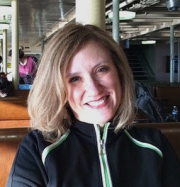

On August 2, 1989, my life changed when my doctor stood by my hospital bed and told me the results of the biopsies he had taken during what was supposed to be a laparoscopic procedure for suspected endometriosis. Three months previously, I had a physical for my well-woman check-up with my ob-gyn. I was a healthy 31-year-old with toddler daughters at home.
As part of the physical, my doctor performed a bi-manual exam that enabled him to really feel my ovaries (this is one hand outside the abdomen and internal fingers to feel the tissue in-between). One of my ovaries was slightly tender, but nothing was found that would have sent me to the doctor. The mass was the size of a grape, according to the ultrasound. We decided to wait three months, and if a mass could still be felt, the plan was to perform a biopsy. When I awoke from the procedure, my doctor informed me that frozen sections on both ovaries showed adenocarcinoma, and he had performed a hysterectomy and staging following intro-operative consent from my husband. I had microscopic cells in the peritoneal fluid, but no metastases were found (there were no gynecological oncologists in Des Moines, Iowa, where we were living at the time).
To say that I was in shock is an understatement. During the three-month waiting period, I still had no abnormal symptoms other than mild cramping when I lifted my daughters into their car seats. Even though I am a registered nurse, I thought ovarian cancer was a disease of older women and knew no one who had ever been diagnosed with this form of cancer. Following the surgery, I began the current treatment of that time, cisplatinum (and then carboplatinum) and cytoxan, followed by a radioactive intra-abdominal rinse that is no longer used. I had to be admitted to the hospital for the infusions, and when the six treatments were completed, I had another surgery to look for microscopic disease that a CT scan might miss. The anti-nausea medications available today were not yet developed and it was a very difficult time. The support, prayers, meals and child-care from family and friends sustained us through this time.
I learned that it was extremely unusual to be diagnosed with ovarian cancer in the absence of symptoms. I am convinced that my diagnosis of Stage IC disease was made because my practitioner was experienced and adept in performing the bi-manual exam. He approached my exam, not from a perspective that I was healthy and symptom-free, but rather with a conviction that if something was there, he was going to find it.
I spent the next twenty years teaching third-year medical students to approach all physical exams with this attitude and curiosity, and I am committed to advocacy for all women to know the signs and symptoms of ovarian cancer. I am also committed to advocacy for this procedure to remain part of a well-woman check-up. No one likes this exam. False positives are a reality, and interventions and costs may be unnecessary in a certain percentage of cases. But I have had twenty-seven years to raise my daughters because I had a practitioner who conducted my exam with skill and accuracy, and this resulted in early detection and my long-term survival. I am grateful beyond words.
Editor’s Note: Julie lives in Happy Valley, Oregon with her husband. Together, they have six children and ten grandchildren. She works for Novartis Pharmaceuticals monitoring clinical trials. In her free time, Julie enjoys riding on the back of her husband’s motorcycle, traveling, decorating, and conducting family history research. Julie is a new board member of the Ovarian Cancer Alliance of Oregon and SW Washington.
